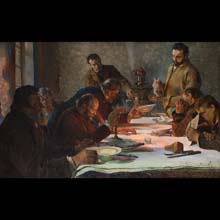
material: oil on canvas
dimensions: 81 × 126 cm
description: During his stay in Paris between 1876 and 1877, Jacek Malczewski took up the subject of deportations to Siberia, drawing inspiration from both the poetry of Juliusz Słowacki and the patriotic and martyrological art of Artur Grottger. The feeling of homesickness for his country also contributed to this particular choice of the subject matter. The artist called it the “malady of the Soplicas,” which caused that one “did not like anything except their own country” [the Soplicas – characters in the epic poem Pan Tadeusz by Adam Mickiewicz]. Malczewski continued working on the Siberian series in the next years, finding inspiration also in Cienie syberyjskie [Siberian Ghosts] by Teofil Lenartowicz with the subtitle Z opowiadania powracającej z wygnania [From a Story of a Woman Returning from Exile] and a shocking epigraph: "Siberia is hell – it can’t be worse there.” Malczewski created his own moving vision of that hell. In Christmas Eve in Siberia, the artist focussed on depicting people’s despair, loneliness and suffering by recalling the most important Polish holiday, spent in the family circle, which is Christmas Eve. However, the religious realities have been minimized here. A group of men have gathered around this special, festive table with a steaming samovar reminding of warmth and homely atmosphere, but also with empty plates and a thick slice of brown bread. Although the men are sitting at one Christmas table, each of them is thinking about his own suffering, memories of life and the things they have lost and will never see again. The atmosphere of despair is enhanced by the mood created by a gloomy range of colours dominated by browns and greys as well as the use of two sources of contrasted, expressive lighting – the cold one, coming from the window, and the warm light of a candle. Urszula Koazakowska-Zaucha
exposition: The Gallery of 19th Century Polish Art in Sukiennice,
The Cloth Hall, 1, Main Market Square
key: Realism, polish impressionism, beginnings of symbolism >>>
dimensions: 81 × 126 cm
description: During his stay in Paris between 1876 and 1877, Jacek Malczewski took up the subject of deportations to Siberia, drawing inspiration from both the poetry of Juliusz Słowacki and the patriotic and martyrological art of Artur Grottger. The feeling of homesickness for his country also contributed to this particular choice of the subject matter. The artist called it the “malady of the Soplicas,” which caused that one “did not like anything except their own country” [the Soplicas – characters in the epic poem Pan Tadeusz by Adam Mickiewicz]. Malczewski continued working on the Siberian series in the next years, finding inspiration also in Cienie syberyjskie [Siberian Ghosts] by Teofil Lenartowicz with the subtitle Z opowiadania powracającej z wygnania [From a Story of a Woman Returning from Exile] and a shocking epigraph: "Siberia is hell – it can’t be worse there.” Malczewski created his own moving vision of that hell. In Christmas Eve in Siberia, the artist focussed on depicting people’s despair, loneliness and suffering by recalling the most important Polish holiday, spent in the family circle, which is Christmas Eve. However, the religious realities have been minimized here. A group of men have gathered around this special, festive table with a steaming samovar reminding of warmth and homely atmosphere, but also with empty plates and a thick slice of brown bread. Although the men are sitting at one Christmas table, each of them is thinking about his own suffering, memories of life and the things they have lost and will never see again. The atmosphere of despair is enhanced by the mood created by a gloomy range of colours dominated by browns and greys as well as the use of two sources of contrasted, expressive lighting – the cold one, coming from the window, and the warm light of a candle. Urszula Koazakowska-Zaucha
exposition: The Gallery of 19th Century Polish Art in Sukiennice,
The Cloth Hall, 1, Main Market Square
key: Realism, polish impressionism, beginnings of symbolism >>>












